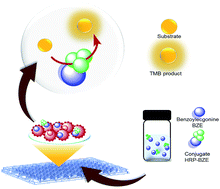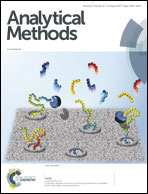Development of competitive ‘pseudo’-ELISA assay for measurement of cocaine and its metabolites using molecularly imprinted polymer nanoparticles†
Abstract
The analytical test-system for cocaine, benzoylecgonine and norcocaine was developed in the ELISA format using molecularly imprinted polymeric nanoparticles (nanoMIPs) as synthetic recognition elements that were produced using a solid-phase synthesis approach. The experimental conditions of the assay were optimized using a Box–Behnken experimental design protocol. The detection of free cocaine and its metabolites was performed using a competitive binding assay in the model samples and in blood plasma. There was no cross-reactivity of the developed assay towards paracetamol and caffeine. The developed assay had a picomolar limit of detection of cocaine (LOD = 4.24 pM), which was almost three orders of magnitude lower than the LOD expected from the commercial antibody-based ELISA (3.3 nM), and other attractive features of a new assay included a long shelf-life, lower economic cost and a short production time. Therefore, it is possible to state that nanoMIPs have the potential to become the recognition elements of choice for the development of a new generation of test-systems and sensors.



 Please wait while we load your content...
Please wait while we load your content...